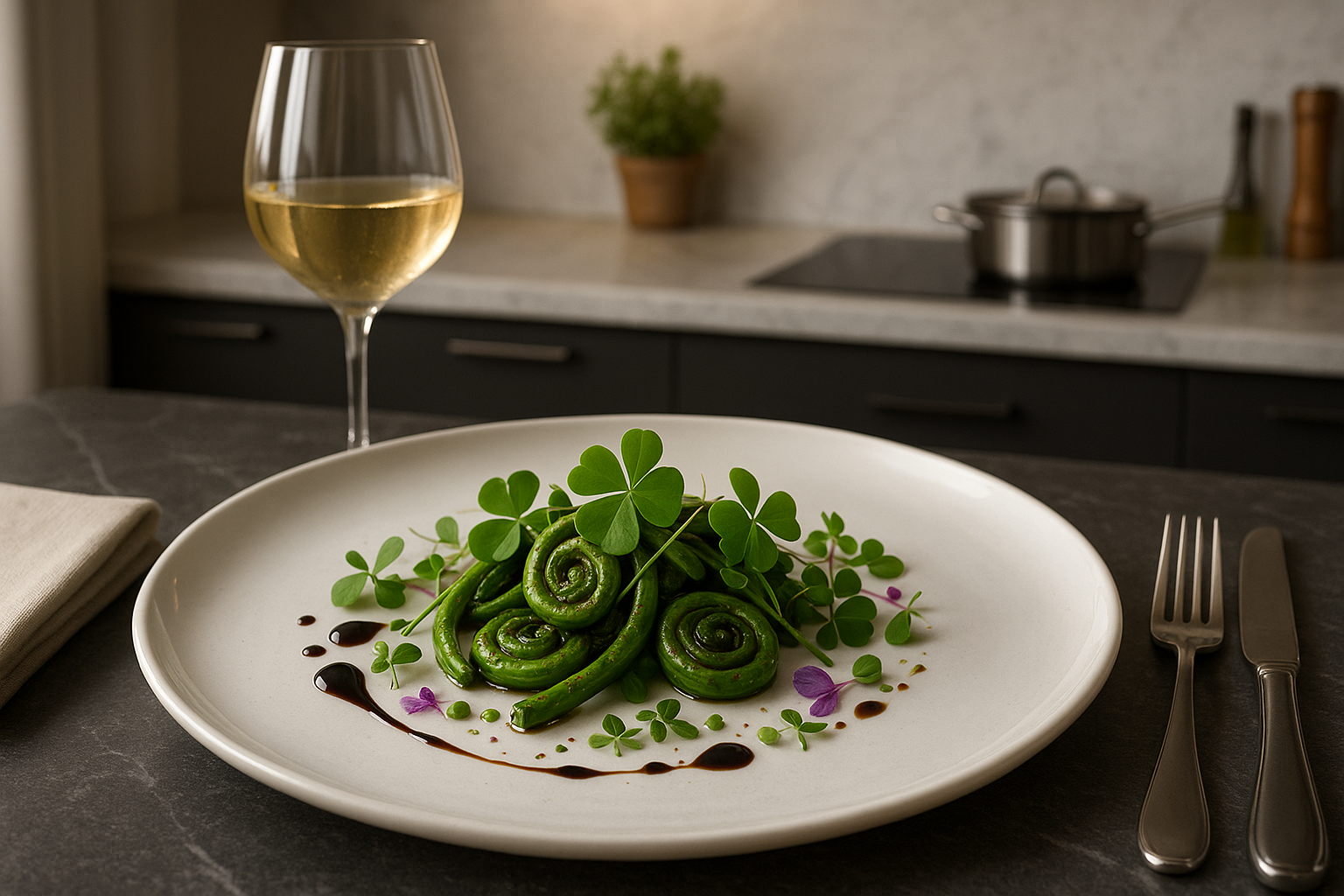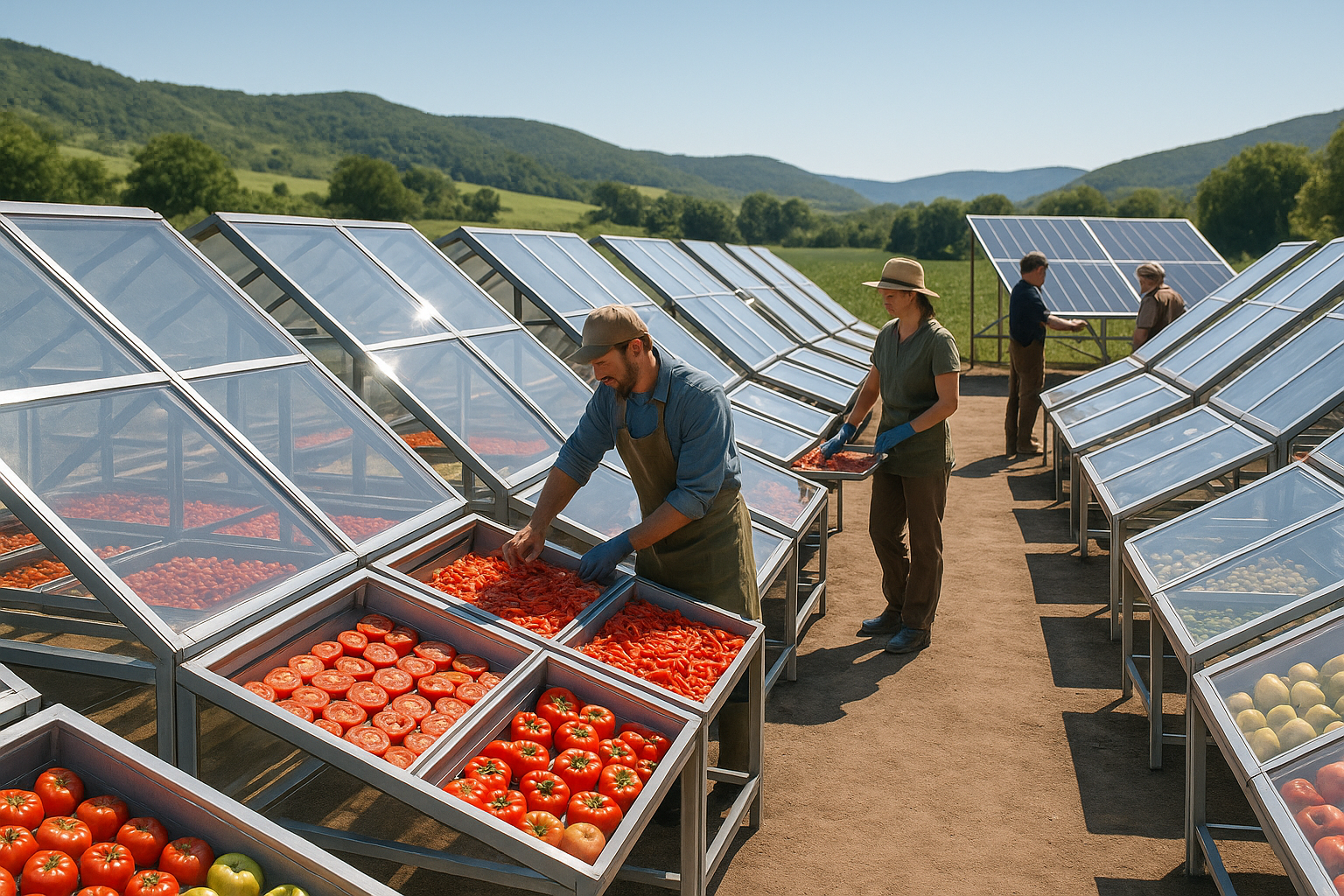Imagine wandering through a sun-dappled forest, the ground carpeted with the lush green of spring’s earliest offerings. Among these treasures, two unique plants stand out, waiting to be discovered by the adventurous gourmand: fiddleheads and wood sorrel. These ingredients, often overlooked, are culinary gems that promise to elevate your gourmet creations to new heights 🌿. As we delve into their world, you’ll find that their distinct flavors and textures can transform ordinary dishes into extraordinary experiences.
Fiddleheads, the young, coiled fronds of the ostrich fern, are a seasonal delicacy, cherished for their crisp texture and subtle, nutty flavor. They’re like nature’s own spiral pasta, ready to be sautéed, blanched, or even pickled, adding both visual appeal and culinary intrigue to your plate. But these vibrant greens are more than just a pretty face. Packed with nutrients, including omega-3 fatty acids, they are as wholesome as they are delightful. The fleeting availability of fiddleheads, typically just a few weeks in spring, only adds to their allure, making them a sought-after ingredient for chefs and home cooks alike.
Then there’s wood sorrel, often mistaken for clover, with its heart-shaped leaves and delicate yellow flowers 🌼. This plant offers a sharp, lemony flavor that can invigorate any dish. Whether tossed in a salad, blended into a pesto, or used as a garnish, wood sorrel introduces a fresh tang that complements a wide array of ingredients. It’s a perfect match for fiddleheads, providing a zesty contrast that highlights their earthiness.
Together, fiddleheads and wood sorrel create a dynamic duo, capable of awakening your culinary creativity. They embody the essence of spring, bringing the vibrant energy of the season into your kitchen. But how do you go from forest to fork, transforming these wild plants into gourmet delights?
In this article, we’ll guide you through the process, starting with how to identify and forage these plants safely and sustainably. Ethical foraging is crucial; it ensures that these natural resources remain abundant for future generations. We’ll provide tips on where to find them, how to harvest responsibly, and the best practices to avoid damaging their habitats.
Next, we’ll delve into preparation techniques. From cleaning and storing to cooking methods that best preserve their unique flavors and textures, you’ll learn how to make the most of these ingredients. For fiddleheads, this includes essential steps to remove their natural bitterness and ensure they’re cooked to perfection. Meanwhile, wood sorrel requires little more than a quick rinse, but we’ll share innovative ways to incorporate it into your dishes for maximum impact.
Finally, we’ll inspire you with a selection of gourmet recipes that showcase the versatility of fiddleheads and wood sorrel. Whether you’re crafting a simple yet elegant appetizer, a refreshing salad, or an intricate main course, these recipes will help you unleash your inner chef. Imagine a creamy fiddlehead risotto with wood sorrel garnish or a tangy wood sorrel dressing drizzled over sautéed fiddleheads 🍽️. The possibilities are endless, limited only by your imagination.
As you explore these culinary frontiers, remember that cooking with fiddleheads and wood sorrel is not just about the end result. It’s an adventure, a chance to connect with nature and embrace the seasonal bounty it offers. By the end of this journey, you’ll not only have expanded your culinary repertoire but also gained a deeper appreciation for the simple yet profound joys of seasonal cooking.
So, whether you’re a seasoned chef looking for new inspiration or a home cook eager to experiment with fresh ingredients, this guide is for you. Let the vibrant flavors of fiddleheads and wood sorrel lead the way, and prepare to wow your taste buds and those of your guests. Get ready to unleash your culinary creativity, one delicious dish at a time!
# Unleash Your Culinary Creativity with Fiddlehead and Wood Sorrel: A Delicious Duo for Gourmet Dishes!
Culinary enthusiasts are constantly on the lookout for unique ingredients that can elevate their dishes from ordinary to extraordinary. In the world of gourmet cooking, the fiddlehead and wood sorrel stand out as an intriguing duo. These lesser-known ingredients bring not only flavor and texture but also a touch of adventure to any culinary creation. Whether you’re a seasoned chef or a home cook eager to explore new tastes, integrating fiddlehead and wood sorrel into your recipes can be a transformative experience.
## Discovering the Unique Characteristics of Fiddlehead and Wood Sorrel
Fiddleheads are the young, coiled fronds of a fern, specifically the ostrich fern, and are typically harvested in the early spring. Their appearance is as captivating as their taste, which is often described as a blend of asparagus, green beans, and artichoke. This makes them a versatile ingredient, perfect for a variety of dishes, from salads to sautés.
Wood sorrel, on the other hand, is a small, herbaceous plant with a tangy, lemony flavor that can add a refreshing zing to your meals. Unlike fiddleheads, which have a short harvesting season, wood sorrel is more widely available, often growing wild in gardens and woodlands. Its clover-like leaves and delicate flowers are not only edible but also make for a beautiful garnish.
### The Health Benefits: More Than Just Flavor
In addition to their delightful flavors, both fiddleheads and wood sorrel offer a range of health benefits. Fiddleheads are rich in vitamins A and C, as well as antioxidants that help combat oxidative stress. They also contain omega-3 and omega-6 fatty acids, which are essential for heart health.
Wood sorrel is no slouch in the nutrition department either. It is an excellent source of vitamin C and has been used in traditional medicine to treat various ailments, from fevers to inflammation. The plant’s high oxalic acid content gives it its characteristic sour taste, which can also aid digestion.
### Culinary Applications: How to Use Fiddlehead and Wood Sorrel
When it comes to incorporating fiddlehead and wood sorrel into your dishes, the possibilities are endless. Here are a few ideas to get you started:
- Fiddlehead Stir-Fry: Sauté fiddleheads with garlic, olive oil, and a splash of lemon juice for a simple yet flavorful side dish.
- Wood Sorrel Pesto: Blend wood sorrel with nuts, cheese, and olive oil for a tangy twist on traditional pesto.
- Spring Salad: Combine fiddleheads and wood sorrel with mixed greens, nuts, and a light vinaigrette for a refreshing salad.
For a visual guide on how to prepare fiddleheads, check out this [YouTube video by Chef John](https://www.youtube.com/watch?v=0ekFaT6fCVw).
## Navigating the Market: Sourcing and Selecting Quality Ingredients
Finding fresh fiddleheads and wood sorrel can be a challenge, especially if you live in an area where they are not commonly available. However, the search is well worth it, as these ingredients can transform your cooking in delightful ways.
### Where to Buy and What to Look For
Fiddleheads are most commonly found in farmers’ markets and specialty grocery stores during their short spring season. When selecting fiddleheads, look for tightly coiled, bright green fronds. Avoid any that are browning or have an unpleasant odor, as these are signs of aging.
Wood sorrel, due to its more ubiquitous nature, can often be foraged in the wild. However, if foraging isn’t an option, some specialty stores might carry it, especially those focusing on organic or wildcrafted foods. Ensure the leaves are fresh and vibrant, free of any signs of wilting or yellowing.
### Storing Your Ingredients for Maximum Freshness
Once you’ve procured your fiddleheads and wood sorrel, proper storage is key to maintaining their freshness and flavor. Fiddleheads should be refrigerated and used within a few days of purchase. It’s best to store them in a plastic bag with a damp paper towel to prevent drying out.
Wood sorrel can be stored similarly, though it typically lasts a bit longer. Keep it in a cool, dark place, and be sure to wash it thoroughly before use to remove any potential dirt or pesticides.
## Elevating Your Cooking: Advanced Techniques and Pairings
Pairing fiddlehead and wood sorrel with other ingredients can enhance their flavors and create a more harmonious dish. These two ingredients can complement a range of other flavors, offering both contrast and synergy.
### Experimenting with Flavor Profiles
Here are some suggested pairings to inspire your culinary experiments:
- Fiddlehead and Seafood: The earthy flavor of fiddleheads pairs beautifully with seafood such as scallops or shrimp, bringing out the freshness of the ocean.
- Wood Sorrel and Dairy: The tangy flavor of wood sorrel complements creamy cheeses and yogurts, making it an excellent addition to cheese plates or yogurt-based dips.
- Herb Blends: Combine wood sorrel with other herbs like mint and parsley to create aromatic and flavorful rubs for meats and vegetables.
### Cooking Techniques: From Simple to Sophisticated
Fiddleheads can be prepared using a variety of methods, each bringing out different aspects of their unique flavor. Steaming or blanching them helps retain their vibrant green color and crisp texture. For a more caramelized flavor, try roasting them with a bit of olive oil and sea salt.
Wood sorrel is best used raw or lightly cooked, as excessive heat can diminish its bright flavor. Use it as a garnish, toss it into salads, or add it at the end of cooking to maintain its freshness.
### A Table of Flavor Enhancers
Enhancing the flavors of fiddlehead and wood sorrel can make your dishes stand out even more. Here’s a quick guide on ingredients that can elevate their natural taste:
| Fiddlehead | Wood Sorrel |
| Lemon zest, butter, garlic | Honey, olive oil, black pepper |
| Parmesan cheese, balsamic vinegar | Sea salt, capers, dill |
| Pine nuts, chili flakes | Cucumber, avocado, lime juice |
## Exploring Cultural and Historical Contexts: A Deeper Dive
Understanding the cultural and historical significance of fiddlehead and wood sorrel can enrich your appreciation for these ingredients and provide additional inspiration for your culinary creations.
### Fiddlehead in Indigenous Cultures
Fiddleheads have been a staple in the diets of various Indigenous peoples across North America. They were traditionally foraged and consumed as one of the first greens of spring, symbolizing renewal and the return of abundance after the harsh winter months. In many communities, fiddleheads were not only valued for their nutritional benefits but also for their spiritual significance, often featured in ceremonies celebrating the changing seasons.
### Wood Sorrel in Folk Medicine
Wood sorrel has been used in traditional folk medicine across different cultures for centuries. Its high vitamin C content made it a valuable remedy for scurvy, especially during long sea voyages in the age of exploration. Furthermore, wood sorrel was often brewed into a tea to relieve fever and stomach ailments, reflecting its long-standing role as a versatile medicinal plant.
### Modern Culinary Trends: Reviving Ancient Ingredients
In recent years, there has been a resurgence of interest in foraged and wild ingredients, driven by a growing desire for sustainable and locally sourced foods. Chefs around the world are rediscovering the unique flavors of fiddlehead and wood sorrel, incorporating them into modern dishes that celebrate both tradition and innovation. This trend not only highlights the importance of preserving culinary heritage but also encourages a more sustainable approach to food consumption.
## Engage with the Community: Share Your Culinary Adventures
As you experiment with fiddlehead and wood sorrel in your kitchen, consider sharing your creations with a broader community. Social media platforms and food blogs are excellent venues for showcasing your dishes and connecting with other culinary enthusiasts who share your passion for unique ingredients.
### Join Online Groups and Forums
There are numerous online communities dedicated to foraging, cooking, and sustainable living. Joining these groups can provide valuable insights, recipes, and tips for using fiddlehead and wood sorrel. Engage with fellow members by sharing your experiences, asking questions, and exchanging ideas.
### Attend Local Workshops and Foraging Tours
Participating in local workshops or foraging tours can deepen your understanding of fiddlehead and wood sorrel, as well as other wild edibles. These events often provide hands-on learning experiences and offer opportunities to connect with experts in the field.
### Document Your Journey
Consider documenting your culinary journey with fiddlehead and wood sorrel through photos, videos, or written narratives. This not only helps you track your progress and experiments but also serves as inspiration for others interested in exploring these unique ingredients.
## Conclusion: A Never-Ending Adventure in Flavor
While there is no formal conclusion here, the journey of discovering fiddlehead and wood sorrel is an adventure in itself, inviting you to explore, experiment, and enjoy. These ingredients offer a tantalizing glimpse into the world of gourmet cooking, where creativity knows no bounds. As you continue to experiment and learn, remember that the culinary world is vast and full of surprises, just waiting to be uncovered. 🌿✨

Conclusion
As we conclude our exploration of fiddlehead ferns and wood sorrel, it’s clear that this wild-foraged duo represents a perfect harmony of freshness, flavor, and nutrition. Fiddleheads bring a delicate crunch and earthy, asparagus-like richness, while wood sorrel adds a bright, lemony tang — together creating a naturally balanced dish that celebrates spring’s vitality.
The true gourmet magic of this pairing lies in its simplicity and connection to place. 🌎💫 Harvested responsibly, both ingredients capture the fleeting essence of early growth — tender, vibrant, and full of renewal. Beyond their taste, they offer antioxidants, vitamins, and a direct link to the landscape itself. Ultimately, celebrating fiddlehead and wood sorrel is more than crafting a seasonal delicacy — it’s honoring nature’s artistry, where flavor, health, and harmony bloom together in every bite.
Toni Santos is a practical visual researcher and culinary historian dedicated to the art and science of survivalist cooking. Through a hands-on and detailed lens, Toni explores traditional and improvised food preparation techniques designed for resilience in extreme and resource-scarce environments. His journey is rooted in a fascination with how humans have adapted their cooking methods to survive—and thrive—in the wild, during crises, and off the grid. From open-fire smoking to solar ovens and fermentation in makeshift containers, Toni’s work uncovers time-tested strategies that transform simple ingredients into vital nourishment. With a background in ethnography and applied survival skills, Toni documents the tools, recipes, and rituals that sustain body and spirit when convenience disappears. His research connects ancient wisdom with modern survivalist innovations, highlighting the interplay of resourcefulness, nutrition, and cultural knowledge. As the creative mind behind Vizovex, Toni shares step-by-step guides, visual tutorials, and thoughtful articles that empower readers to master cooking techniques essential for preparedness, self-reliance, and outdoor living. His work is a tribute to: The ingenuity behind emergency and off-grid cooking The cultural heritage of survival food traditions The art of transforming basic resources into life-sustaining meals Whether you’re a prepper, an outdoor enthusiast, or simply curious about food’s role in survival, Toni welcomes you to explore a world where every flame, tool, and ingredient tells a story of endurance and care.




